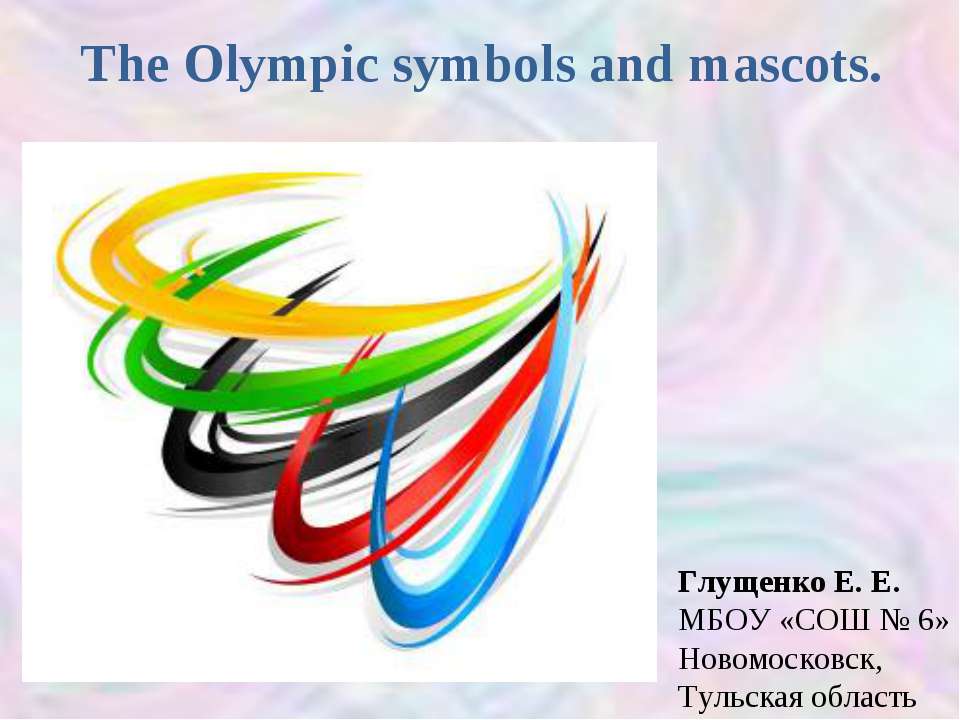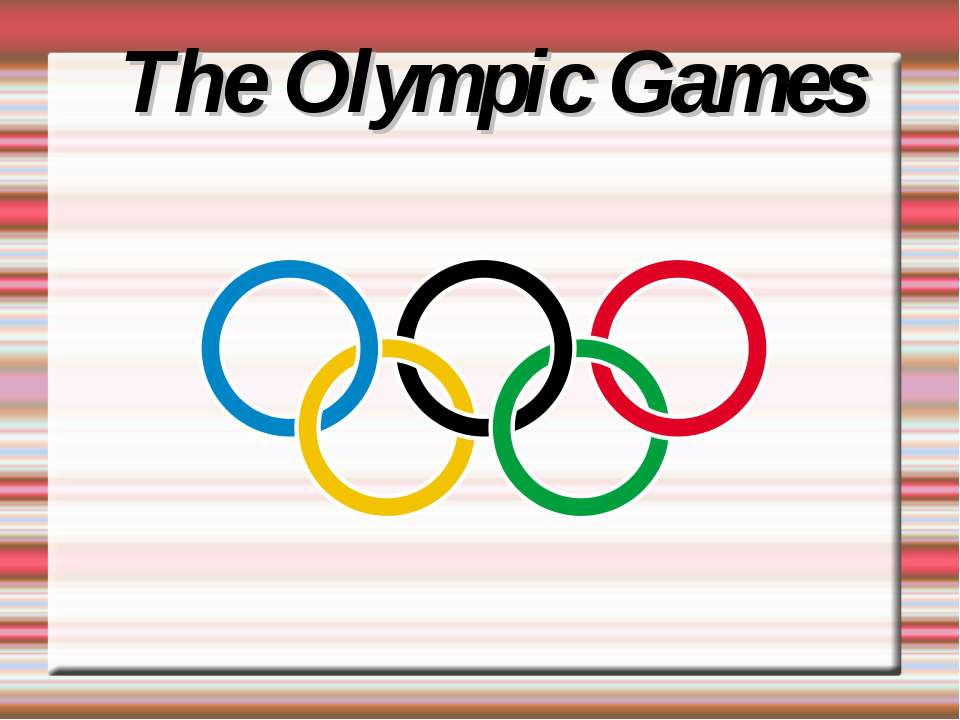The Olympic symbols and mascots

- Рубрика: Презентации / Презентации по английскому языку
- Просмотров: 527
Презентация "The Olympic symbols and mascots" онлайн бесплатно на сайте электронных школьных учебников edulib.ru
The Olympic symbols and mascots. Глущенко Е. Е. МБОУ «СОШ № 6» Новомосковск, Тульская область
The meaning and the values of Olympics are conveyed by symbols. Among these are the rings, the motto and the flame. These symbols transmit a message in a simple and direct manner. They give the Games and the Olympic Movement an identity.
The Olympic medals awarded to winners are another symbol associated with the Olympic games. The medals are made of gold-plated silver (commonly described as gold medals), silver, or bronze, and awarded to the top 3 finishers in a particular event. The kotinos (Greek: κότινος), is an olive branch, originally of wild olive-tree, intertwined to form a circle or a horse-shoe, introduced by Heracles. In the ancient Olympic Games there were no gold, silver, or bronze medals. There was only one winner per event, crowned with an olive wreath made of wild olive leaves from a sacred tree near the temple of Zeus at Olympia. The Olympic medals The kotinos
The rings The five rings represent the five continents. They are interlaced to show the universality of Olympics and the meeting of the athletes of the world during the Olympic Games. On the Olympic flag, the rings appear on a white background. Combined in this way, the six colours of the flag (blue, yellow, black, green, red and white) represent all nations.
The motto A motto is a phrase which sums up a life philosophy or a code of conduct to follow. The Olympic motto is made up of three Latin words : citius- altius- fortius. FASTER — HIGHER — STRONGER These three words encourage the athlete to give his or her best during competition. To better understand the motto, we can compare it with the Olympic creed : The most important thing in life is not the triumph, but the fight ; the essential thing is not to have won, but to have fought well.
The flame The Olympic flame is one of the best-known features of the Games. From the moment the flame is lit, a very precise ritual is laid down : – The lighting. In memory of the modern Olympic Games’ ancient origins, the flame is lit in Olympia (Greece) some months before the opening of the Games. The Olympic flame can only be lit by the sun’s rays. – The torch. A new torch is created for each edition of the Games. Each relay runner carries his or her own torch: it is the flame which is passed from runner to runner and which cannot be extinguished.– The relay route. Carried by relay from Olympia to the host city of the Games, the flame crosses different regions, countries and continents.
The Olympic mascots are fictional characters, usually an animal native to the area or human figures, who represent the cultural heritage of the place where the Olympic Games are taking place. The mascots are often used to help market the Olympic Games to children, particularly infants. Since the 1968 Winter Olympics in Grenoble, France the Olympic Games have had a mascot. Starting with the 2010 Vancouver mascots, the Olympic and Paralympic mascots have been presented together. The Olympic mascots
Schuss was the unofficial mascot of the 1968 Winter Olympics in Grenoble, France, featuring a cartoon character wearing skis. 1968 Summer Olympics. There were unoffical dove and jaguar mascots in Mexico city. The Jaguar mascot was based on a throne in the shape of a red jaguar in the "El Castillo" pyramid at Chichen Itzá. The stylized white dove represented the slogan of the games, "Los juegos de la Paz" or "Games of the Peace".
It was not until the Summer Games in Munich in 1972 that the first official Olympic mascot was created. "Waldi", the first official mascot to appear for the 1972 Munich Games, was a Dachshund. He was modelled after Cherie von Birkenhof, a longhaired breed of the species. Very popular in Bavaria, Waldi also possesses qualities that are indispensable to an athlete: resistance, tenacity, and agility. Waldi was dressed in pastel colors to express the gaiety and joy of the Olympic festival.
1976 Olympic Winter Games in Innsbruck – Snowman. It represents the Games of Simplicity. "Amik" the beaver was chosen as the official mascot for the Summer Olympic Games of Montreal, 1976. "Amik" in Indian language means beaver. The beaver has always been associated with hard work.
1980 Olympic Winter Games in Lake Placid – Roni (Raccoon). Its face design resembles the hat and goggles used by competitors. Named for the Adirondack mountain range. The Moscow Olympic 1980 bear "Misha" was developed by the renowned illustrator of children's books Victor Chizikov. A second, less well-known mascot, was also present during the Moscow Games . The mascot was a seal named "Vigri", who represented the yachting events in Tallinn.
1984 Olympic Winter Games in Sarajevo – Little wolf, Vucko. It helped to change the common perception in the region of wolves as frightening and blood-thirsty. The eagle "Sam" became the mascot of the Los Angeles Games1984. He was chosen because the imposing bald eagle is the national symbol of the United States. Sam is a cartoon eagle who is dressed in the style of the legendary Uncle Sam, with a star-spangled background in red, white, and blue, the national colors of the United States.
1988 Olympic Winter Games in Calgary, Canada – Hidy and Howdy, two polar bears. Both represent Western Canadian hospitality "Hodori", the mascot of the 1988 Olympic Games in Seoul, South Korea, portrays the friendly side of a tiger, which is present in many Korean legends. The "Ho" in "Hodori" comes from the Korean word for tiger, and "Dori" is a common masculine diminutive. The Olympic rings adorn the neck of Hodori, and he wears a "Sangmo" hat from a traditional farm dance. The streamer on his hat in the shape of an S stands for Seoul.
1992 Olympic Winter Games in Albertville – Magigue. Magique was a snow imp. It plays with the concept of dream and imagination through its star-like shape. The Spaniards did not immediately take to "Cobi", the surreal dog from the Summer Olympic Games of Barcelona 1992, who was designed by local cartoonist Javier Mariscal. "Cobi's" popularity slowly grew and by the end of the Games he was loved universally by the Spanish and the rest of the world.
1994 Olympic Winter Games in Lillehammer - Håkon and Kristin, two Norwegian children, both are dressed in Viking clothes. The mascot of the 1996 Summer Olympic Games in Atlanta was an amorphous abstract fantasy figure. It carried the name "Izzy", derived from "Whatizit?" because no one seemed to know exactly what "Izzy" really was.
1998 Olympic Winter Games in Nagano, The Snowlets: Sukki, Nokki, Lekki and Tsukki, four owls. Representing the four major islands of Japan. The first syllable of each name combines phonetically to create the word "Snowlets". "Ollie", a Kookaburra, "Syd", a Platypus; and "Millie", an Echidna, are three native animals chosen as mascots for the Sydney 2000 Games. These Australian animals represent the earth, air and water. "Ollie": epitomizes the Olympic spirit of generosity and universal generosity (from Olympic). "Syd": represents the environment and captures the vigour and energy of Australia and its people (from Sydney). "Millie": is a techno-whiz and information guru, with all the facts and figures at her fingertips (from Millennium).
2002 Olympic Winter Games in Salt Lake City - Powder , Snowshoe Hare, (Swifter). Copper, Coyote, (Higher). Coal, American black bear, (Stronger). All three mascots are indigenous animals of the US state of Utah, and are named after natural resources important to the state's economy. These animals are major characters in the legends of local American Indians, and these legends are reflected in the story of each mascot. To remind them of this heritage, all mascots wear a charm around their neck with a petro glyph image.
Phevos and Athena are the two official Athens 2004 mascots. Their creation was inspired by an ancient Greek doll and their names are linked to Ancient Greece, yet they are children of modern times. His name is of one Olympian god: Phevos, the god of light and music, known as Apollo. Her name is of one Olympian god: Athena, goddess of wisdom and patron of the city of Athens. Phevos and his sister, Athena, represent the link between Greek history and the modern Olympic Games.
2006 Olympic Winter Games in Turin – Neve and Gliz, a humanized snowball and ice cube. The five Beijing Olympic Games mascots are officially called the Fuwa. They are Beibei, the fish; Jingjing, the panda; Huanhuan, the Olympic flame; Yingying, the Tibetan antelope; and Nini, the swallow. The first syllables from their two-syllable names form a line that reads "Beijing Huanying Ni", or in English – "Welcome to Beijing". The mascot’s colours were chosen in line with the colours of the Olympic rings. Beibei represents the blessing of prosperity, Jingjing the blessing of happiness, Huanhuan the blessing of passion, Yingying the blessing of health and Nini the blessing of good luck.
2010 Olympic Winter Games in Vancouver: Miga is a mythical sea bear, part orca and part Kermode bear, a rare white bear that only lives in British Columbia. Quatchi is a young sasquatch, the sasquatch is a popular figure in local native legends of the Pacific West Coast. Sumi is an animal guardian spirit who lives in the mountains of British Columbia, from Galactic News. Sumi’s name comes from the Salish word “Sumesh” which means “guardian spirit.” Muckmuck, a Vancouver Island Marmot, an official mascot, but their designated “sidekick“.
2012 Summer Games in London - Wenlock and Mandeville. Drops of steel with cameras for eyes. Wenlock's name was inspired by the Wenlock Olympian Society, an annual Olympic event held in Wenlock, England. Mandeville takes his name from the Stoke Mandeville Games. Wenlock wears five bracelets in the five Olympic ring colors. The three points on his head symbolize the three podiums of the winners (for first, second, and third place), the shape of his head is the same shape as the Olympic stadium, and on his body the logo of the game is printed. Mandeville wears a pink watch set to 0:20:12, and on his head there are three points in red, blue, and green representing the Agitos, which is the symbol of paralympic games.
2014 Olympic Winter Games in Sochi – Bely Mishka (the Polar bear), the Snow Leopard, Zaika (the dore hare), the Ray of Light and the Snowflake.
http://talisman.sochi2014.com/en/history/ http://en.wikipedia.org/wiki/List_of_Olympic_mascots http://en.academic.ru/dic.nsf/enwiki/383280 http://en.academic.ru/dic.nsf/enwiki/11853385 http://articles.gourt.com/en/Olympic%20Flag http://www.mapsofworld.com/olympic-trivia/olympic-mascot.html http://listverse.com/2012/07/24/top-10-crazy-olympic-mascots/ http://encycl.opentopia.com/term/Olympic_symbols http://ru.freepik.com/free-vector/olympic-sports-pictograms-olympic-sports-gymnastics-trampoline-pictogram-clip-art_379188.htm Источники информации:




























